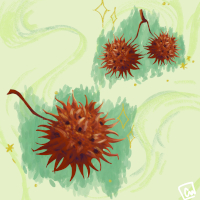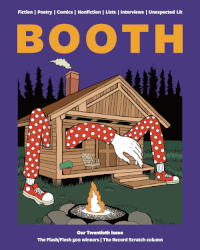It’s the seventh cycle since they started trying and only nine days post ovulation when she gets her first positive, the pink so faint she hardly believes it.
She holds the strip up to the light, squints at the test line, and then sets it down on the sheet of notebook paper by the edge of the sink.
9 DPO, 7:05 a.m., FMU, she writes in black Sharpie next to the test. Positive.
As the days pass, she adds to her collection of strips, arranges them like soldiers rank and file. Daily, she examines the progression, a study in pink.
In the mirror after her shower the day her period is due, she presses her hand to her stomach, the folds of skin soft against the flat of her palm.
“Don’t worry,” she reassures her husband, who watches, bemused, from the bed. “I’m not getting attached.”
At five weeks and not quite seven days, she starts bleeding. Monday morning, 8 a.m. spin class, the thump of EDM pulsing through the room.
“Up and out of those saddles, girls,” the instructor calls from the front. “Don’t you dare drop that cadence.”
When she rises from her seat, she feels it, a throbbing ache in her lower back, her abdomen clenching tight, the cramps keeping time with the beat.
In the bathroom, she wraps toilet paper around her hand. She slips the wad into her underwear, the cotton gusset rust red and wet with old blood.
Implantation bleeding versus miscarriage, she types into her phone while she waits for the train on her way to work.
Early pregnancy bleeding, backache, cramps, she tries again at her desk.
Later, tuning out at the all-hands-on-deck weekly meeting, Can exercise cause period-like symptoms, 5w6d pregnant, 39 years old?
And later still, as the sky purples and day recedes: Was miscarriage my fault?
On the phone with the nurse the next morning, she asks what she could have done, what she should do now.
“Will I need an ultrasound? Will—will it pass on its own?”
“At this stage, it’s what we call chemical,” the nurse replies. “There’s nothing there.”
“I’m not hungry,” she tells her husband in the evening when he suggests going out for Thai.
“I told you not to test so early. You’ve had abortions older than this,” he says. “I don’t understand.”
“I never wanted them,” she says as she sweeps her test strips into the trash.
Softening, he reaches for her hand. “At least now we know you still can.”
She pulls away. “No, of course, you’re right.” She turns off the bathroom light. “Sure, why not. Let’s go out.”
The next day, a hunk of tissue, red and amorphous, drops into the toilet with a plop. Using her bare hands, she scoops up the clot and carries it out to the porch where, in a broken planter long forgotten, she buries it beside a dead calathea.
“Is it planting season already?” her neighbor remarks from his driveway.
“Oh, no,” she laughs. She presses the mound of dirt down with her fingers and then, standing, wipes her hands on her jeans. “Just doing a little housekeeping.”
Two months pass, and in the soft light of early spring, she walks past the dead calathea only to stop short in her tracks. From the soil, beside the withered stalks, a tiny shoot the yellow-green of fresh growth.
She takes the pot inside and sets it down on the kitchen table.
“Would you look at that,” her husband says as he pours himself a cup of coffee. “You brought it back to life.”
The tender sprig, which radiates heat, trembles at her touch.
“Her,” she says absently. “I brought her back.”
In the cold exam room at her next appointment, she waits for the doctor to tell her the options, her skin goose-bumped beneath the thin blue gown. She crosses and uncrosses her legs and clasps her hands, clammy with sweat, in her lap.
The doctor glances down at her chart, then asks her age, how many months now since she last bled.
“It’s perimenopause,” he intones.
“What did the doctor say?” her husband asks when she gets home. “What about IVF?”
The ginger tabby sniffs at the plant, which has grown half a foot. She shoos the cat away. Thumbing a shriveled leaf, brown at its edges, she frowns.
“Nothing,” she says. “There’s nothing we can do.”
The next morning, she wakes with a hollow ache in her chest and salt crusted in streaks down her face.
“I’m sorry,” her husband says in the kitchen, the planter in pieces on the floor. “The cat—I couldn’t—”
From the spilled soil, she digs up what’s left. Cradling the plant, its chewed roots caked with dirt, she carries it back outside. In a hole beneath the shade of an oak, she places it gently down.
By midsummer, the plant has twisted up and up. Oval leaves the size of small saucers and veined in silvery pink unfurl from its branches.
On the breeze, the shush of leaves and a hint of something sweet and faintly milky.
“What’s this?”
Her husband crouches down beside her where she weeds. With a stick, he prods a fibrous tuft of orange at the plant’s base.
“Oh, that?” she says as she pulls up a clump of thistle. “Just trying out a new fertilizer.”
Her fortieth birthday comes and goes.
“What about adoption?” her husband suggests the next day. “Or a dog?”
At the sink, as she stirs a pink slurry of milk and raw meat, she looks out the window. The boughs of her tree, now grown as large as the oak, sway and bend in the rain. Deep within her, something shifts, a loosening, release.
“I don’t think so,” she says, then returns to her work.
Late autumn, and she wakes once more in pain. Her breasts, which are swollen and heavy, leak a yellow, sticky fluid like sap.
“You need to see a doctor,” her husband says, a hand on her shoulder as she examines her chest, her fevered skin cracked and tinged vaguely green.
Wincing, she lowers her shirt. “No,” she says, shrugging him away. “It’s fine.”
Outside, at the foot of her tree, its canopy newly bare, a sere scatter of leaves.
Kneeling, she presses her cheek to its rough bark, inhales its familiar scent, the thrum of wind like the steady rise and fall of breath.



